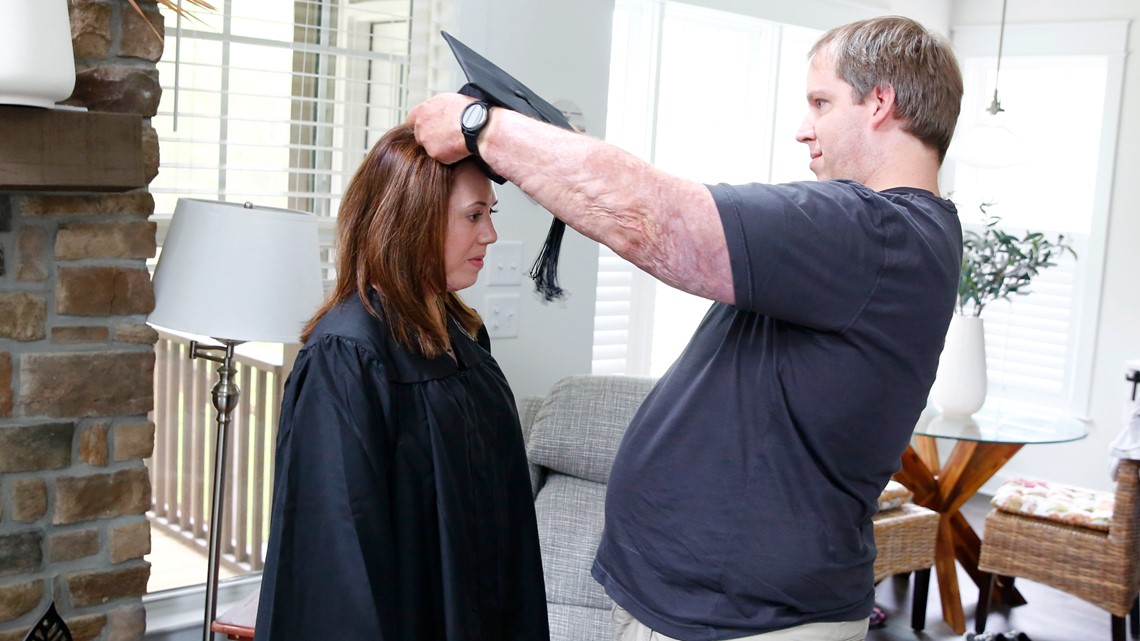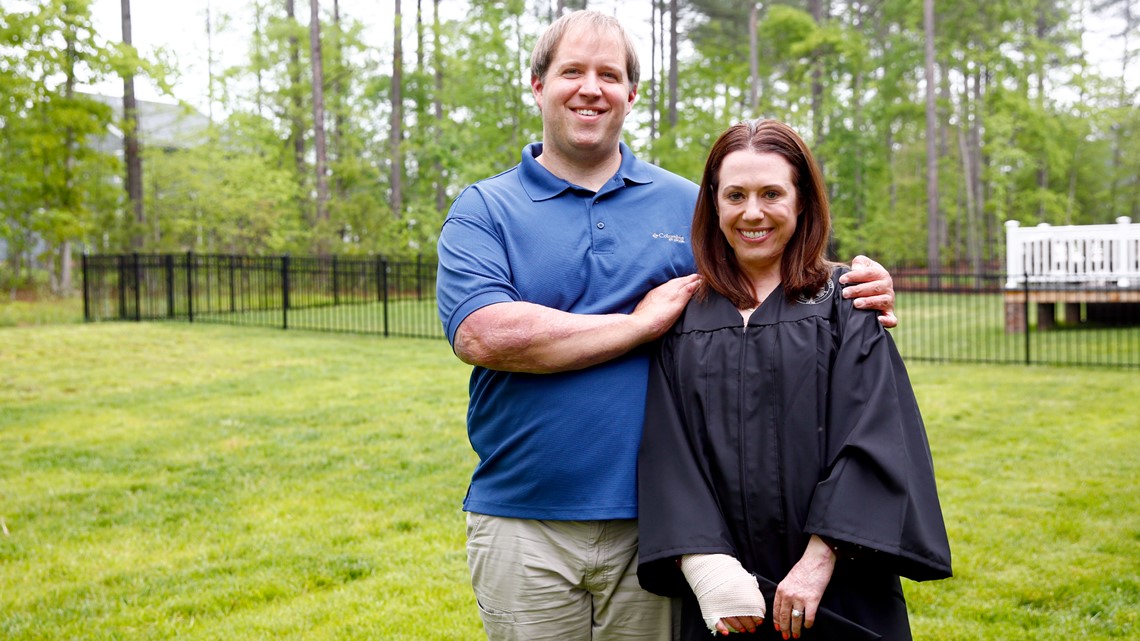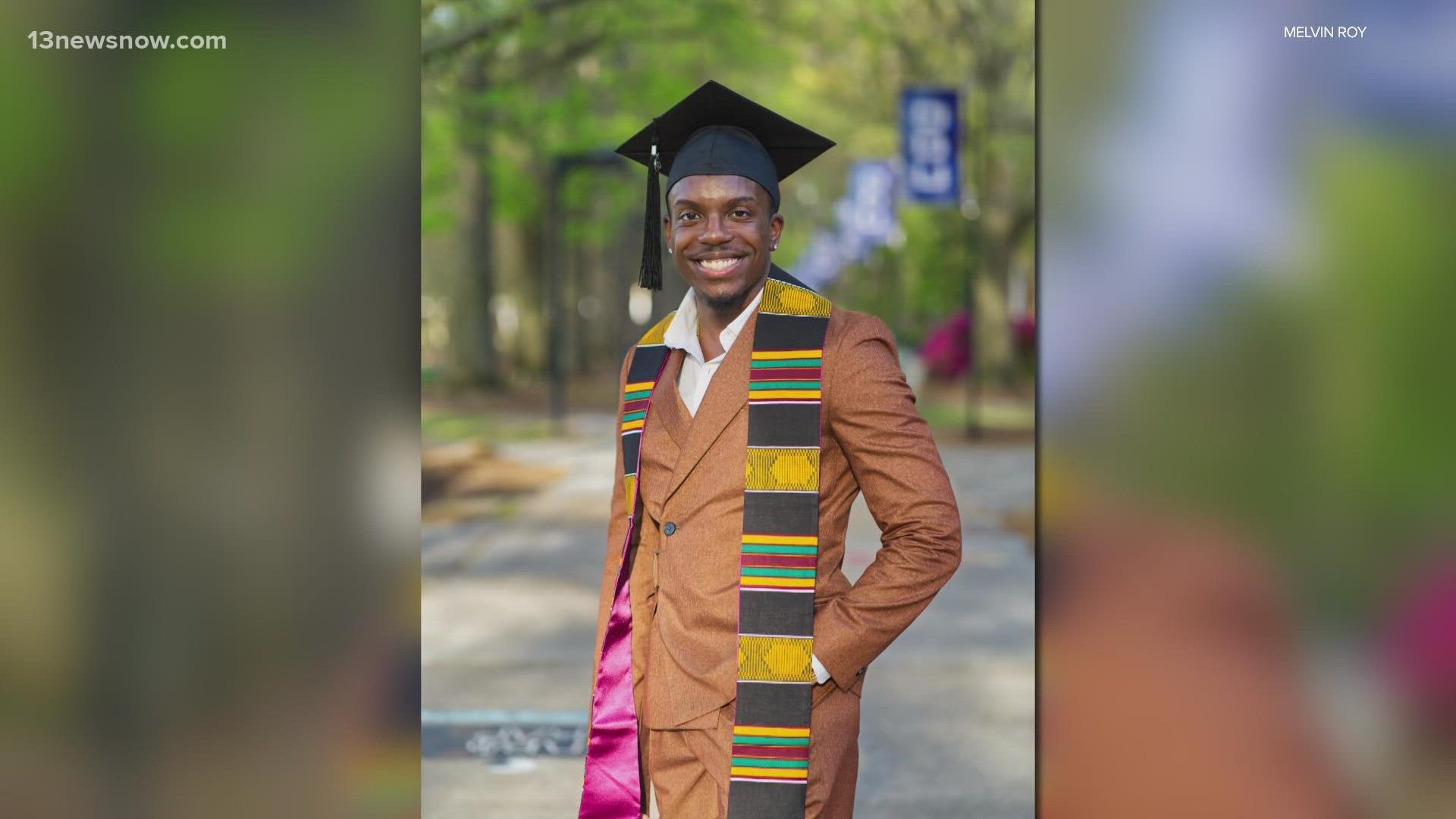CHESTERFIELD, Va. — Author's note: The video above is on file from a separate story that aired on May 5, 2022, about a different ODU graduate.
There was a moment when she and her husband, Matt, were hunkered down behind a boulder — holding hands and saying “I love you” as a storm of volcanic ash, rock and acids engulfed them, turning a bright sunny afternoon to night — that Lauren Urey was almost certain they weren’t going to make it safely off the South Pacific island.
“I felt like I was going to get buried alive,” she recalled. “I thought there was no way we were going to survive this.”
Though others visiting New Zealand’s White Island perished when the island’s volcano erupted on Dec. 9, 2019, the Ureys did indeed survive, though they suffered horrific burns, a nightmarish rescue and months — and now years — of surgeries, treatments and scars.
In trying to regain their old lives, the Ureys have returned to their jobs and moved into a new home in Chesterfield County, and on May 7 they celebrated another major milestone on the long road back: Lauren, 35, graduated from Old Dominion University with a degree in medical laboratory science.
“A big day,” Lauren said.
It’s Lauren’s second bachelor’s degree; she graduated from Radford University with a degree in marketing in 2010. However, locating a job with long-term prospects proved difficult in a shaky economy, so she shifted gears and looked toward the medical field for a career. She pursued an associate’s degree in medical laboratory technology from Reynolds Community College, which helped her land a job in the field.
After taking a semester off, she enrolled in ODU’s online medical laboratory science degree completion program, which she began in the fall of 2019.
In October that year, she and Matt married (“We met on Match.com,” she says. “We’re one of those success stories.”) and planned a honeymoon to Australia and New Zealand. She received permission from her professors to take her final exams early, and she and Matt left on the day after Thanksgiving.
They started their trip in Australia and then went on a Royal Caribbean cruise, making several stops in New Zealand. On Dec. 9, they took a shore excursion to New Zealand’s White Island, about 30 miles from New Zealand’s North Island in the Bay of Plenty, for an up-close look at an active volcano.


According to The New York Times, an online promotion for the tour invited tourists to “get close to the drama. Gas masks help you get near roaring steam vents, bubbling pits of mud, hot volcanic streams and the amazing lake of steaming acid.”
There was no mention, however, Matt Urey recalled, that the New Zealand agency that monitors geological activity in the country had reported increased activity at the volcano for several weeks and had raised the warning level to 2 on a scale of 0-5. Two is “moderate to heightened volcanic unrest,” while 3, 4 and 5 are levels of eruptions.
“They didn’t tell us the volcano was already at level two,” he said. “That was never communicated to us. I didn’t find out until after I woke up (from a medically induced coma). We definitely would not have gone on that island had we known.”
Lauren agreed, saying, “We’re definitely not adventurous people. We’re not the type to go skydiving or anything like that. We’re a very, very boring couple.”
They thought the trip to the island would be “a cool, fairly leisurely thing,” she said, recalling a brochure that recommended against people in wheelchairs making the trip.
“It didn’t sound like it was going to be that adventurous,” she said.
The Ureys have filed suit against Royal Caribbean. A trial is scheduled for Oct. 24, according to one of the couple’s attorneys from a Miami law firm.
The Ureys said their contingent of visitors was divided into two groups. They were in the first group that hiked to the edge of the crater for a look. They headed down as the second group approached the crater. A few minutes later, as the Ureys were part-way down the hillside, the volcano erupted. One of the other tourists said, “Hey, everyone, look!” A mushroom cloud of black ash began to rise from the crater. A tour guide yelled, “Everyone, run!”
Recalled Lauren, “I just had a sinking feeling in my stomach.”
They found a boulder that provided a minimal amount of shelter. Rocks pelted them, and “black smoke and ash were coming out of everywhere,” she said. “I was holding my husband’s hand and screaming and telling him how much I loved him.” It felt like forever, she said, but they later learned the eruption lasted for only about two minutes.
Trapped in a black fog and badly burned already, they struggled to make their way back to the water. Lauren fell multiple times; at least on one occasion, her right hand went into thick, blisteringly hot ash, severely burning her palm. She’s undergone numerous hand surgeries, the most recent of which was last week.
They made it to an inflatable dinghy, which returned them to the larger tour boat and a painful, 90-minute trip to the mainland, their scorched skin exposed to the sun and saltwater. Lauren, who drifted in and out of consciousness on the ride, was the first passenger off the boat since she was in the most critical condition.


She was taken to the burn unit at a hospital in Auckland. Matt was taken to a hospital in Christchurch, more than 600 miles away. Lauren was burned over 23% of her body, Matt over 53% of his. Physicians put both in medically induced comas, her for almost three weeks and him for 12 days. They wouldn’t see each other again until February, back in Richmond, at VCU Medical Center.
As badly as they were hurt, in many respects, they were fortunate. Most of those in the second tour group had just arrived at the rim of the crater when it erupted. In all, 22 people were killed that day, including 20 visitors and two tour guides.
The journey back to the life the Ureys knew has been long and, at times, agonizingly slow. Besides therapy and other treatment, Lauren has undergone more than two dozen surgeries, averaging one a month, mostly at Johns Hopkins Hospital in Baltimore. She hopes to be done with the surgeries by the end of the year.
They both bear scars from the experience. Lauren struggles with post-traumatic stress and depression; Matt, 38, formerly an avid runner, can no longer run because he suffers from heat intolerance: his body is unable to cool down properly because his grafted skin doesn’t sweat.
“Summers are pretty rough for me,” he said.
However, in some ways, their progress has been remarkable.
Both long ago returned to their jobs: Lauren as a medical laboratory technician for Bon Secours Richmond Health System, Matt as a mechanical engineer at DuPont where he works, ironically, with flame-resistant fiber.
Returning to hospital work during COVID-19 was risky for Lauren as she developed a lung infection because of the eruption, and COVID samples came through the lab where she worked on a daily basis.
“It was very stressful,” she said. “But we were short-staffed, and honestly I enjoy what I do. I like helping people, and I like staying busy.”
She took only a semester off from ODU before resuming her studies. For her perseverance, she was awarded one of the inaugural scholarships funded by the Commonwealth Transfusion Foundation, which emphasized that, aside from traditional students, they also wanted to support medical laboratory technicians pursuing their bachelor’s degrees.
Urey’s graduation also means a promotion at her job to clinical laboratory scientist, she said.
She is looking forward to putting her surgeries in the rear-view mirror, so she and Matt can start a family. She’s determined not to let what happened on White Island dictate the rest of her life.
“I want to prove to everybody ... that just because something horrible happens to you, it doesn’t mean your whole life has to change,” she said. “It doesn’t have to be the end of the world. It didn’t stop me. It didn’t stop my husband.
“It was horrible what happened, but we were not going to let this ruin what we had. We’re determined not to let this be the end of the world for us.”



